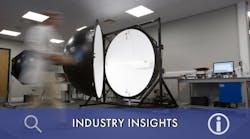Osram Opto Semiconductors has announced the Ostune family of packaged LEDs that specifically target automotive interior lighting. The phosphor-converted white LEDs are available over a broader CCT range than is typical in auto-targeted LEDs. Moreover, the inclusion of 90-CRI products in the portfolio means car designers can layer solid-state lighting (SSL) in cabins much like lighting designers do for architectural spaces.
The LEDs are AEC-Q102 qualified for automotive applications, meaning the components are designed for what can be a harsh environment even inside an auto — think temperature extremes, vibration, and humidity. Generally, auto-qualified LEDs have been available in narrower-CCT ranges and at relatively lower CRIs than white LEDs intended for general lighting applications. But the Ostune products span from 2700K to 6500K CCT and feature the aforementioned 90 CRI, enabling a significant improvement in cabin light quality.
We’ve written quite a lot in recent years on cabin lighting often focusing on dynamic color technology such as that enabled by the ISELED Alliance technology originally developed by Inova Semiconductors. Osram joined that alliance back in 2018. And Osram immediately announced a color-tunable product. But such color lighting is more focused on ambience.
The Ostune family is intended to allow the car designer to light specific areas in the cabin for functionality. For example, a reading light or a makeup mirror might need different spectra for ideal functionality, although both would benefit from 90-CRI performance.
“Ambient lighting is becoming increasingly important with each new generation of vehicles,” said Hermann Senninger, marketing manager for automotive interior at Osram Opto Semiconductors. “With our Ostune product family, completely new designs are now possible, transforming the atmosphere in the interior from a functional workplace to a cozy living room simply by adjusting the color temperature.”
Now the above quote and indeed the Ostune brand name can confuse. The announced Ostune LEDs are not individually tunable over a CCT range the way the two-emitter Nichia 2-in-1 LEDs can be tuned at the device level. That Nichia product is not targeted at the auto cabin, but we mention it just as an example. If a car designer wants to implement dynamically tunable white light with Ostune, a two-channel design would be required. Still, the wider-than-typical CCT span in an auto-qualified LED family makes such a design possible.
There are two sub families of Ostune — the W1608 and E3030. As those model numbers imply, the LEDs feature 1.6×0.8- and 3×3-mm footprints, respectively. A 3500K version of the smaller LEDs delivers 7.5 lm at 30 mA of drive current. The larger LED delivers 24 lm at 60 mA of drive current at the same CCT.
Automotive lighting remains very much a growth market for LED manufacturers. The application requires premium-level components. The design-in cycle can take lengthy periods, but the demand is steady once a product using such LEDs is launched. And the automotive-qualified LEDs aren’t subject to the price erosion commonplace in white LEDs for general illumination.
We covered some of this data in our report on the Strategies Unlimited global LED forecast that was presented at Strategies in Light back in February. Revenue for packaged LEDs in automotive applications is just over a $3B (billion) market today. About one third of that is in interior lighting applications. And although revenue for exterior lighting such as headlamps will continue to grow faster than interior applications, Strategies Unlimited projects a 7% compound annual growth rate for interior lighting LED revenue through 2024.
For up-to-the-minute LED and SSL updates, why not follow us on Twitter? You’ll find curated content and commentary, as well as information on industry events, webcasts, and surveys on our LinkedIn Company Page and our Facebook page.






